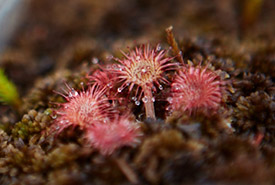South of Shawinigan - The Lac-à-la-Tortue Bog

Lac-à-la-Tortue Bog (Photo by Martin Beaulieu)
Discover the Lac-à-la-Tortue bog
The Lac-à-la-Tortue bog is the largest bog in the St. Lawrence Valley and it mainly receives its water only from rain and snow. This type of bog is called ombrotrophic as it is characterized by an acid pH and a supply of minerals that come only from precipitation.
Located in the Mauricie region, with a total of area of 66 square kilometres, the Lac-à-la-Tortue bog is the largest peat complex in the St. Lawrence Lowlands. It began forming 10,000 years ago, and over its entire history has accumulated a total of 6.36 megatons of terrestrial carbon.
Wetlands provide us with many ecological services, particularly by absorbing large quantities of water during heavy rainfall or rapid snowmelt. This buffering effect helps prevent streams near the bog from overflowing. In addition, bogs are considered important carbon sinks that contribute to lessening the impacts of global warming. For these reasons, protecting this type of environment is essential.
The Nature Conservancy of Canada (NCC) began its work in this area in 2005, and now protects more than 48 square kilometres of the Tourbière-du-Lac-à-la-Tortue nature reserve and nearly 49 square kilometers (4,900 hectares) within the Lac-à-la-Tortue Bog. This is an area almost twice the size of Oka National Park. The site straddles the municipalities of Shawinigan, Notre-Dame-du-Mont-Carmel, Saint-Narcisse and Saint-Maurice. The provincial government also protects a significant area within its Lac-à-la-Tortue ecological reserve: in all, approximately 81 per cent of the wetlands in this area are now protected.
It is possible to see the Lac-à-la-Tortue bog via the trails of Cœur nature park, located in Saint-Narcisse. University researchers are also studying the ongoing status of the bog as well as the ecological and physical processes.
Caribou savannah
The Lac-à-la-Tortue bog area, formerly known as the ''caribou savannah'' is home to a wide variety of animals, including beaver, coyote, redbelly snake, smooth green snake, wood frog and green frog. Moose, black bear and white-tailed deer are the large mammals that use this vast site. In addition, there are several ponds and swamps here that are home to many waterfowl, including black duck, wood duck, great blue heron and blue-winged teal. Sandhill cranes have also been seen on numerous occasions. There are also plant species considered to be at-risk, such as Virginia chain fern.
Several species at risk have also been spotted and identified in the bog, including little brown bat, red bat, silver-haired bat, Canada warbler, common nighthawk and whip-poor-will.
Historical research sometimes reveals facts that are surprising and forgotten by most of us. For example, the Montreal Herald and Daily Commercial Gazette of Monday, December 18, 1882, mentions a hunting project in the area, between the municipalities of Mont-Carmel and Lac-à-la-Tortue, by a group of Montreal sportsmen. They reported the presence of ''immense herds of woodland caribou,'' which explains its caribou savannah nickname.
Setting the course for COP26!
In September 2021, a team of scientists from the Université du Québec à Montréal took a 50-centimetre-deep section of soil, called a core, from the Lac-à-la-Tortue peat bog. The core was sent to Glasgow, Scotland and presented at an event specifically focusing on the role of peatlands in the fight against climate change as part of COP26.
Partners
This project was made possible with financial support from devoted volunteers and many partners, including the Ensemble pour la nature project of the Ministère du Développement durable, de l’Environnement et de la Lutte contre les changements climatiques du Québec, the Government of Canada’s Natural Areas Conservation Program, the MapleCross Fund, the ECHO Foundation, the U.S. Fish & Wildlife Service (through its North American Wetlands Conservation Act), Cogeco, Sanimax and other donors who wish to remain anonymous.








NCC would like to thank forest asset management company Solifor, a company of the Fonds de solidarité FTQ, from which NCC acquired the property, for its extensive collaboration throughout this project.
This project is part of the Quebec Ecological Corridors Iniative (QECI) launched by the Nature Conservancy of Canada and led by 10 organizations and their many partners. The QECI offers a collective approach to land use planning to accelerate the conservation of nature areas connected by ecological corridors.




